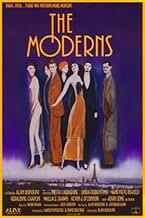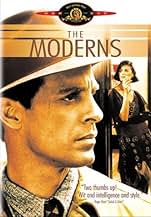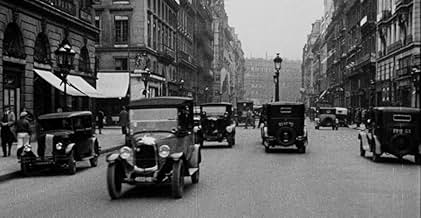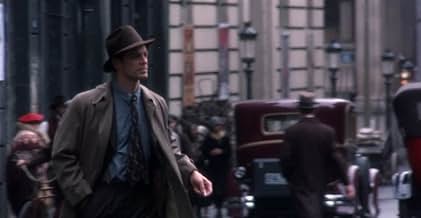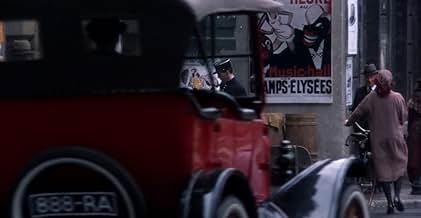NOTE IMDb
6,6/10
2,2 k
MA NOTE
Ajouter une intrigue dans votre langueA struggling artist is hired to forge paintings, causing him to cross paths with his ex-wife and her powerful new husband.A struggling artist is hired to forge paintings, causing him to cross paths with his ex-wife and her powerful new husband.A struggling artist is hired to forge paintings, causing him to cross paths with his ex-wife and her powerful new husband.
- Réalisation
- Scénario
- Casting principal
- Récompenses
- 2 victoires et 5 nominations au total
Geneviève Bujold
- Libby Valentin
- (as Genevieve Bujold)
Charlélie Couture
- L'Evidence
- (as Charlelie Couture)
Véronique Bellegarde
- Laurette
- (as Veronique Bellegarde)
Avis à la une
A couple years ago I saw Trouble in Mind, and was immediately absorbed in the atmospheric world the film portrayed. I have since been dying to see another movie by the same director. Well, I've just seen the Moderns, and was immediately disappointed. While the film shares the same claustrophobic tendencies of the previous work, in this one it doesn't seem as deliberate, but more a matter of budgetary restraints. I never got the feeling that I was watching Paris, or 1920's Paris, for that matter. All I got was the sensation of watching stilted actors playing dress-up. The dialogue and plot for this movie is b-movie crust, which can be good, but the dreariness of the action and the way in which the film was filmed left it almost completely vacant of any charm. Cute references to pop culture from the 20's only sounds contrived and makes the film more apparent of what it isn't. One should get the feeling one is watching the 20's unfold without the crutch of references. We are never given any reason to care for any of the actors. They are cartoonish, but not cartoonish enough for them to be relieving and enjoyable. This movie takes itself far too seriously to be enjoyed as camp, which makes scenes involving fake suicide and real suicide all the more dour. The sets are perhaps more wooden than the characters, Hart's art atrocious. Hemmingway appears as a jocular Ethan Hawke ruffian, a pale shadow compared to Hart's masculinity. Lampooning famous people can be fine, but not when the only purpose of it is to rip them off and make them a clown with no real relevance to the story. I did, however, like the portrayal of Gertude Stein as a cliquish art snob. That's a more fair assessment. To be missed or slept through.
This is a fairly enjoyable tale set in the art world of 1920s Paris. The look of the film and the mood it creates are the most important things; far more important than the enjoyable, yet slow-moving plotline.
It is highly imaginative and its representation of icons such as Ernest Hemingway and Gertrude Stein add an extra dimension to the film.
The only true weak points are some of the dialogues between the two leads; it is sometimes out of place and almost too 'modern'!
All the performances are good but John Lone and Keith Carradine are especially suited to their parts.
It is highly imaginative and its representation of icons such as Ernest Hemingway and Gertrude Stein add an extra dimension to the film.
The only true weak points are some of the dialogues between the two leads; it is sometimes out of place and almost too 'modern'!
All the performances are good but John Lone and Keith Carradine are especially suited to their parts.
*****SPOILER ALERT!!!*****
Alan Rudolph's "The Moderns" is a wonderful, funny and twisted film set in 1920's Paris, France. The front burner story is a triangle between Nick, his runaway wife and a cold as ice businessman that wants to obtain a higher social status. Nick(Keith Carradine)and Rachel(Linda Fiorentino)were married years ago and she bails out of the marriage. Years later, she shows up on the arms of Bertram Stone (John Lone). While he deals with her reappearance, he is also talked into making art forgeries by a rather shady behaving gallery owner, Valentin(Genevieve Bujold), as a favor for the wealthy Nathalie De Ville(Geraldine Chaplin). His friend, Oiseau (Wallace Shawn)constantly tells Nick that they should head to a new town called Hollywood to seek their fortune and Ernest Hemingway (Kevin J. O'Connor)wanders around in a state of alcoholic cynicism and making quirky observations.
The story, like the period in which the action takes place, is surreal. One scene has one of the dead characters rise from the grave like Houdini, strait-jack, chains and all. The relationship between Nick and Rachel is the heart of the story: Nick doesn't want to trust Rachel because of what she did, but all of his actions throughout the film are a result of Rachel. When he paints the forgeries, he thinks of Rachel's beauty and puts his feelings on canvas. He loves her, but is fighting with the possibility that if he opens his heart to her again, she will break it again. You can see this conflict when he slaps her in front of Stone, yet immediately becomes apologetic. Should he love her, or should he just back off? He clearly does when they share a sexual romp on the bathroom floor while her husband is downstairs.
The entire cast is great, but the best performance comes from O'Connor, who I think is one of the most underrated actors around.
This is a great movie to have if you feel like having a Paris night movie marathon, or just to have fun.
Alan Rudolph's "The Moderns" is a wonderful, funny and twisted film set in 1920's Paris, France. The front burner story is a triangle between Nick, his runaway wife and a cold as ice businessman that wants to obtain a higher social status. Nick(Keith Carradine)and Rachel(Linda Fiorentino)were married years ago and she bails out of the marriage. Years later, she shows up on the arms of Bertram Stone (John Lone). While he deals with her reappearance, he is also talked into making art forgeries by a rather shady behaving gallery owner, Valentin(Genevieve Bujold), as a favor for the wealthy Nathalie De Ville(Geraldine Chaplin). His friend, Oiseau (Wallace Shawn)constantly tells Nick that they should head to a new town called Hollywood to seek their fortune and Ernest Hemingway (Kevin J. O'Connor)wanders around in a state of alcoholic cynicism and making quirky observations.
The story, like the period in which the action takes place, is surreal. One scene has one of the dead characters rise from the grave like Houdini, strait-jack, chains and all. The relationship between Nick and Rachel is the heart of the story: Nick doesn't want to trust Rachel because of what she did, but all of his actions throughout the film are a result of Rachel. When he paints the forgeries, he thinks of Rachel's beauty and puts his feelings on canvas. He loves her, but is fighting with the possibility that if he opens his heart to her again, she will break it again. You can see this conflict when he slaps her in front of Stone, yet immediately becomes apologetic. Should he love her, or should he just back off? He clearly does when they share a sexual romp on the bathroom floor while her husband is downstairs.
The entire cast is great, but the best performance comes from O'Connor, who I think is one of the most underrated actors around.
This is a great movie to have if you feel like having a Paris night movie marathon, or just to have fun.
This may not be everyone's cup of tea, but it has a genuine, unpretentious charm to it that I found appealing.
Alan Rudolph made this delightful little ode to lies, trickery and delusion on a shoestring budget. The story of a failed painter down on his luck in Paris in the 1920's who accepts a comission to forge a famous impressionist painting. The film questions what is real versus what is perceived or subjective. In a series of criss-crossing subplots and seemingly random encounters Rudolph has fun playing with the trickery of film to made some sly points about the art forms we hold dear.
The film was shot in Montreal, Canada, standing in for Paris and New York in the 1920's, with French-Canadian actors playing Parisians... The plot twists include a millionaire art collector publicly slashing a priceless painting, thinking it a forgery, while the fake painting is sent to hang in a New York museum. A Dadaist poet fakes his own death in order to attend his funeral to hear the things people will say about him. Same character, named L'Oiseau is actually an American ex-patriate named Fagelman! In a toungue-in-cheek hommage to people's perception of the period, Rudolph has Papa Hemmingway hanging-out in all the cafe's and at all the parties... He is seemingly everywhere, sipping scotch and mouthing tough-guy cliches...
But the viewer must beware of what he is watching. In a scene where Bujold's character rides in a taxi with Carradine's we are treated to lovely rear projection shots through the cab's back window of impressionist paintings of Paris at night! In another dimly lit cafe scene Rudolph chose to end the scene by panning away from the action to the bar where among the extras in period costume, two punk rockers are watching a hockey game on t.v.
Alan Rudolph made this delightful little ode to lies, trickery and delusion on a shoestring budget. The story of a failed painter down on his luck in Paris in the 1920's who accepts a comission to forge a famous impressionist painting. The film questions what is real versus what is perceived or subjective. In a series of criss-crossing subplots and seemingly random encounters Rudolph has fun playing with the trickery of film to made some sly points about the art forms we hold dear.
The film was shot in Montreal, Canada, standing in for Paris and New York in the 1920's, with French-Canadian actors playing Parisians... The plot twists include a millionaire art collector publicly slashing a priceless painting, thinking it a forgery, while the fake painting is sent to hang in a New York museum. A Dadaist poet fakes his own death in order to attend his funeral to hear the things people will say about him. Same character, named L'Oiseau is actually an American ex-patriate named Fagelman! In a toungue-in-cheek hommage to people's perception of the period, Rudolph has Papa Hemmingway hanging-out in all the cafe's and at all the parties... He is seemingly everywhere, sipping scotch and mouthing tough-guy cliches...
But the viewer must beware of what he is watching. In a scene where Bujold's character rides in a taxi with Carradine's we are treated to lovely rear projection shots through the cab's back window of impressionist paintings of Paris at night! In another dimly lit cafe scene Rudolph chose to end the scene by panning away from the action to the bar where among the extras in period costume, two punk rockers are watching a hockey game on t.v.
This film is, first of all, a love story--but a remarkably surprising one, and by no means ordinary. It starts with the usual expectations most of us have about Paris that Woody Allen recently utilized so effectively in Midnight In Paris, but instead of broad comedy, Director Alan Rudolph weaves a fascinating tale of intrigue in the art world, and peppers it with wit and ambiguity.
The smoky Parisian ambiance of Bohemian Cafes (mostly created in Canada) introduce the viewer to Keith Carradine's stereotypical starving artist--except that Carradine's role is written to surprise, and one is drawn into a labyrinth of conflicting emotions very quickly indeed. This film, like Thieves Like Us, demonstrates what a fine under-utilized actor Carradine continues to be.
The feeling of elation that comes from escaping from one's cares in another place washes through every bar and café and art opening, and the performances from such vibrant actors as kinky Geraldine Chaplin and quirky Wallace Shawn--and especially the intensely cold and controlled and fascinating John Lone enliven the two hours that linger long after the film is finished.
The smoky Parisian ambiance of Bohemian Cafes (mostly created in Canada) introduce the viewer to Keith Carradine's stereotypical starving artist--except that Carradine's role is written to surprise, and one is drawn into a labyrinth of conflicting emotions very quickly indeed. This film, like Thieves Like Us, demonstrates what a fine under-utilized actor Carradine continues to be.
The feeling of elation that comes from escaping from one's cares in another place washes through every bar and café and art opening, and the performances from such vibrant actors as kinky Geraldine Chaplin and quirky Wallace Shawn--and especially the intensely cold and controlled and fascinating John Lone enliven the two hours that linger long after the film is finished.
Le saviez-vous
- AnecdotesIsabella Rossellini screen-tested to play Nathalie DeVille, but lost to Geraldine Chaplin.
Meilleurs choix
Connectez-vous pour évaluer et suivre la liste de favoris afin de recevoir des recommandations personnalisées
- How long is The Moderns?Alimenté par Alexa
Détails
Box-office
- Budget
- 3 500 000 $US (estimé)
- Montant brut aux États-Unis et au Canada
- 2 011 497 $US
- Week-end de sortie aux États-Unis et au Canada
- 20 283 $US
- 17 avr. 1988
- Montant brut mondial
- 2 011 497 $US
- Durée2 heures 6 minutes
- Couleur
- Mixage
- Rapport de forme
- 1.85 : 1
Contribuer à cette page
Suggérer une modification ou ajouter du contenu manquant





